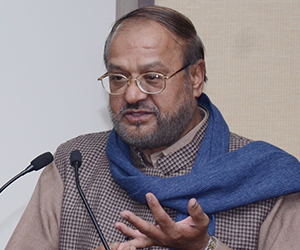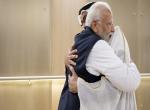Somanath temple came in news in a big way again in the recent months. This was after almost three decades when it was in the news because Mr. Lal Krishna Advani started his Rama Janmabhumi temple rathyatra from Somanath. It was a very symbolic gesture in the sense Advani desired to convey that Rama Janmabhumi temple will be built with the participation of people and the government alike; exactly the way Somanath temple was built after the independence.
In the recent times, the Temple came in news again due to Rahul Gandhi’s tours in the wake of Gujarat elections. His visits were meant to convey the people of Gujarat that he was a devotee of Lord Shiva and a janeu-dhari (the sacred thread wearing) Brahmin. When Rahul Gandhi visited the temple and the Congress party took pride in announcing his visit wearing janeu (sacred thread), it declared him to be a Brahmin and a Shiva-bhakta.
Indians in general do know how and who destroyed the famous and venerated Lord Somanath temple but very few know how it was rebuilt and what kind of teething troubles it faced before the sacred ceremony of prana-pratishtha could be performed. This article deals with the issues regarding the rebuilding of Somanath temple. It is a fitting tribute to K.M. Munshi whose 131st birth anniversary falls on 30th December, 2017.
Emotional attachment and psychological feelings in the minds of every Indian regarding the destruction of Somanath temple and its standing ruins have been well explained in an article by K.M. Munshi written in 1922. He writes:
“Desecrated, burnt and battered, it still stood firm – a monument to our humiliation, and ingratitude. I can scarcely describe the burning shame which I felt on that early morning as I walked on the broken floor of the once-hallowed sabhamandap littered with broken pillars and scattered stones. Lizards slipped in and out of their holes at the sound of my unfamiliar steps, and Oh! the shame of it! – an inspector’s horse, tied there, neighed at my approach with sacrilegious impertinence.” 11
The Nawab of Junagarh would just not allow the Hindus to re-built and renovate the crumbling temple which marked the holy spot where Yogeswar Lord Krishna left his mortal remains. However, after the accession of Junagarh to India in October 1947, Sardar Patel and N.V. Gadgil went to Prabhas Patan and visited the ruins of Somanath Temple. While walking along the ruins, N.V. Gadgil requested Sardar for the restoration of the Somanath temple which was immediately accepted by him, and in a public meeting on the same evening Sardar Patel announced:
“On this auspicious day of the New Year, we have decided that Somanath should be reconstructed. You people of Saurashtra should do your best. This is a holy task in which all should participate. That the Government of India has decided to rebuild the temple and install the shrine.”
Junagarh administration and the Jam Saheb gave donation each on the spot. And 5000 acres of land around the temple was marked for the temple and various other projects like a Sanskrit University, Culture Centre, building of monument at the place of Dehotsarga and indeed, development of the town Prabhash which had fallen into neglect.
However, Maulana Abul Kalam Azad, the then Education Minister and great friend of Nehru, opposed the idea and in one of the Cabinet meetings argued that the ruins should be handed over to the Archaeological Survey of India (ASI) to be preserved in the same ruinous condition as a historical monument. The Minister, however, had not suggested similar measures to be taken for the Muslim shrines and mosques, repairing of which were being done by the ASI under his Ministry. But Sardar Patel was very firm and resolute regarding the rebuilding of the temple and responded with a note stating:
“The Hindu sentiment in regard to this temple is both strong and widespread. In the present conditions, it is unlikely that this sentiment will be satisfied by mere restoration of the temple or by prolonging its life. The restoration of idol would be a point of honour and sentiments with the Hindu public.”3
The Government of India decided that the temple would be constructed by it, as it was being done in the case of Muslim shrines and mosques. Nehru indeed presided over the Cabinet meeting in which this decision was taken. The work began in the right earnest. The whole scheme was discussed with Gandhi ji also who approved of the entire scheme except that the funds necessary for the building of temple should come from public. Thereafter the idea that the Government of India should finance the reconstruction of the temple was given up.
Sardar Patel passed away on 15 December, 1950. After the passing away of Sardar, Nehru started criticizing the whole project and became very hostile not just to the project but to those cabinet colleagues – mainly K.M. Munshi and V.N. Gadgil – who were associated with it right from the beginning. Both N.V. Gadgil’s and K.M. Munshi’s writings bring this out very clearly. As preparations began for the prana-pratishtha according to the shashtras, the President of India, Dr. Rajendra Prasad, was requested to do the ceremony. In the midst of these preparations, once after a Cabinet meeting, Nehru called Munshi and said: “I don’t like your trying to restore Somanath. It is Hindu revivalism.” Munshi not only felt very hurt but took the comments to imply that the things were done on his back and without his knowledge. To this Munshi replied: “I would go home and inform about the things that had happened.”4
On 24 April, 1951, K.M. Munshi wrote a very long letter detailing the entire process regarding Somanath temple. But for this letter, many things regarding the rebuilding of Somanath temple would have remained completely unknown. 5 Munshi writes (for the complete letter may please see Secular Politics Communal Agenda6):
“After the Indian Army was invited into Junagadh by the Dewan of the ex-Nawab, Sardar, Jam Saheb and Gadgil went to Junagadh. Next day, on 13 November, 1947, they went to Prabhas to see the ruins of the Somanath Temple. There they decided upon the reconstruction of the Somanath Temple. It was publicly announced by the Sardar ‘that the Government of India had decided to rebuild the temple and install the shrine.’ Jam Saheb and the Junagadh Administration both gave a donation each on the spot. Junagadh Administration agreed to develop the town of Prabhas and to place at the disposal of the Somanath Temple about 5,000 acres of land for its development. The States Ministry of the Government of India thereafter took steps to implement this decision.
On 13 December, 1947, the Standing Committee of the Public Work, Mines and Power (WMP) Ministry accepted Gadgil’s proposal that the Government of India should reconstruct the temple in the original form and develop roughly one square mile of the surrounding area. I understand that this decision was included in the Weekly Note to the Cabinet. As I learnt from Gadgil, it was also mentioned to the Cabinet. At the time, the decision of the Government was that the W.M.P. Ministry should reconstruct the old shrines and they were so doing in the case of certain Muslim shrines and mosques. The Government of India, thereafter, deputed Government architects to visit Prabhas and prepare a report for the reconstruction of the temple. When the whole scheme was discussed by Sardar with Bapu, he stated that it was alright except that the funds necessary for re-constructing the temple should come from the public. Gadgil also saw Bapu and Bapu gave him the same advice. Thereafter, the idea that the Government of India should finance the reconstruction of the temple was given up … .
On 25 December, 1947, the States Ministry requested the Junagadh authorities to lease out a sufficiently large area surrounding the temple for development on the lines decided upon. The Junagadh authorities thereafter took steps to earmark the area that was to be given for the temple. The matters were discussed at considerable length between the administration of Junagadh and myself who was asked by Sardar to look into the matter. Ultimately, Sardar approved of the area that was to be given to the temple … .
On 23 January, 1949, a Conference was held at Jamnagar attended by Sardar, Jam Saheb, Gadgil, Dhebar, the Chief Minister of Saurashtra, Samaldas Gandhi, Administrator of Junagadh, and the Regional Commissioner. Then the States Ministry had decided to transfer the temple properties to a Somanath Trust to be created for the purpose. At that conference the scheme was finalised. It was decided that the Trust should be executed by the Saurashtra Government; and that the Government of India and the Saurashtra Government should each have two representatives on the Board of Trustees. I was, thereafter, asked by the States Ministry to prepare a Trust Deed for the purpose, which I did … . Several Government servants, including Dr. J.C. Ghosh, Chemist, and the Town-Planning Expert of the Government of India were members of the Committee. The Director-General of Archaeology was appointed the Convener, and in view of my fairly intimate knowledge of ancient history of Gujarat, and particularly of Somanath, I was appointed the Chairman of the Committee. As a Chairman, I took up the implementation of the scheme in closest co-operation with the States Ministry… .
On 18 October 1949, Sardar approved of this Trust. Government of India appointed Gadgil and Rege, Regional Commissioner of Saurashtra, as their representatives on the Board of Trustees; it also nominated Shri B.M. Birla and myself as public men; Saurashtra Government nominated Jam Saheb and Samaldas Gandhi as their nominees. In inviting Gadgil to be a Trustee it was specifically mentioned that in view of the fact that he was the head of the Ministry of WMP, it was appropriate that he should be one of the Trustees.
On 22 November, 1949, the States Ministry wrote to Jam Saheb as follows:
‘Somanath is an ancient heritage of ours, and we have to take every care to see that the temple and its environments are maintained in a manner worthy of their ancient traditions. For this purpose we propose to constitute a Trust. Your Highness will remember that Sardar made an appeal for funds for the Somanath Trust sometime ago....’
The objects of the Trust Deed make it clear that the temple is not only to be open to all classes of Hindu community, but, according to the tradition of the old temple of Somanath, also to non-Hindu visitors; that the area should be developed as a model town; that educational institutions including a university and agricultural farm should be established. The intention to throw open the temple to Harijans has evoked some criticism from the orthodox section of the community… .
Sardar himself was to have not only attended the inaugural ceremony, but actually to perform the ceremony. Unfortunately, the temple could not be completed, and he died in the meantime. Apart from any other sentiment, we all feel that we should help in the redemption of Sardar’s pledge to the best or our ability…. As you will see, the Government of India not only took the initial decision to reconstruct the temple, but formulated and set going the scheme, and created the agency for its further implementation. This will clearly indicate to you the extent of the Government of India’s association with the scheme… .
Yesterday you referred to ‘Hindu revivalism.’ I know your views on the subject; I have always done justice to them; I hope you will equally do justice to mine. Many have been the customs which I have defied in personal life from my boyhood. I have laboured in my humble way through literary and social work to shape or reintegrate some aspects of Hinduism, in the conviction that that alone will make India an advanced and vigorous nation under modern conditions… .
One word more. It is my faith in our past which has given me the strength to work in the present and to look forward to our future. I cannot value freedom if it deprives us of the Bhagavad Gita or uproots our millions from the faith with which they look upon our temples and thereby destroys the texture of our lives. I have been given the privilege of seeing my incessant dream of Somanath reconstruction come true. That makes me feel—makes me almost sure—that this shrine once restored to a place of importance in our life will give to our people a purer conception of religion and a more vivid consciousness of our strength, so vital in these days of freedom and its trials.”
N.V. Gadgil, the then Minister of Urban Development and Rehabilitation (MUDR), has also mentioned this about-turn of Nehru after Sardar’s death. Gadgil writes:
“Another important work I remember is the restoration of Somanath Temple… I prepared a plan and recorded it in the proceedings of the Cabinet. The Maulana said that the site should be preserved as it was. I said that the intention was to restore it to its original state and thus to destroy a silver of distrust between the Hindus and the Muslim…. Earlier it had been decided to undertake the work through the Central Government. [But] On Gandhiji’s advice, it was decided to entrust the work to a Trust which would have one representative of the Central Government.
The Government of India appointed a committee of two engineers and one architect for the supervision of the work. By 1951, the whole of the base of the temple was ready as also the inner altar. We requested President Rajendra Prasad to be the chief participant in the installation of the Lingam…
As is usual with Munshi, he gave the enterprise a grandiloquent turn and wrote to our Ambassador in Peking, Panikkar, to send the waters of Chinese rivers for the ceremony.7 Panikkar, that secular Ambassador, asked the Ministry of External Affairs to what particular head of account the expenses on that could be debited and the letter was placed before Nehru… Nehru expressed the opinion that the President should not attend the ceremony. The Cabinet also discussed the matter… I quoted from the Cabinet reports to prove that Nehru’s charge that the thing was done without informing the Cabinet was not correct. The Maulana and Jagjivan Ram said that the matter was discussed. Government of India had spent about hundred thousand rupees on the work. I pointed out that the Government gave subsidies and grants to thousands of mosques and tombs and there could be nothing objectionable if it spent a little money in restoring a Hindu temple. I understood secularism to mean the equality of all religions… Millions of Hindus are idol-worshippers and not intellectuals like Nehru. Some of us are subject to the weakness of a firm faith…”8
The above two quotations speak for themselves and bring out rebuilding of the Somanath temple was not such a smooth task, after all. Even after the completion of temple building uncertainties remained regarding the installation of deity (pran-pratishtha). The then President of India, Dr. Rajendra Prasad, was requested to preside over the ceremony. Nehru strongly advised the President to desist from going to Somanath for the installation ceremony of Shiva Linga in the temple. However, the President not only ignored Jawaharlal Nehru’s advise, and did go to Somanath for the ceremony. On that occasion he delivered a speech in Hindi which is a master peace of philosophy, culture, history and literature capturing essence of India’s soul.
References:
1. K.M. Munshi, 1922, in East and West. As quoted in ‘Somanath: Fulfilment of a Collegian’s Dream’, Bhawan’s Journal, Jan.1, 1967.
2. K.M. Munshi, 1967, Pilgrimage to Freedom, Appendix 105, p. 560.
3. Ibid.
4. K.M. Munshi, 1951, Pilgrimage to Freedom, pp. 560-64.
5. K.M. Munshi’s letter to Jawaharlal Nehru dated 24 April, 1951. In K.M. Munshi, above.
6. Also reproduced in Makkhan Lal, 2008, Secular Politics Communal Agenda, pp. 150-154.
7. K.M. Munshi had written to all the Ambassadors for the water and soils from the country in which they were posted. This was to be used, as per the provisions of shashtras at the time of Pran-Pratistha and the inauguration ceremony of the temple.
8. N.V. Gadgil, 1968, Government From Inside, Meerut, pp. 185-186;
(Views expressed are of the author and do not necessarily reflect the views of the VIF)
(The Author is a Professor & Founder Director of Delhi Institute of Heritage Research and Management.)
Image Source: http://www.wondertravelhub.com/gujarat.html



.jpeg)






Post new comment